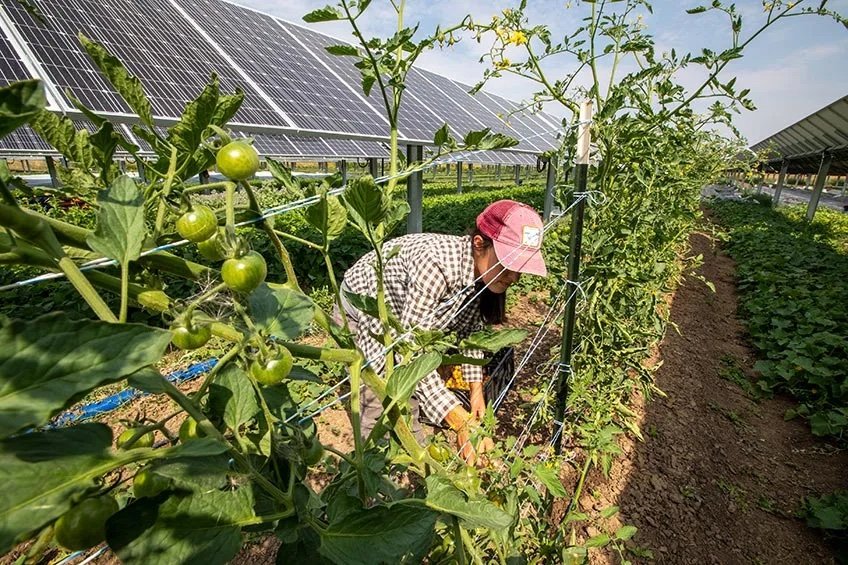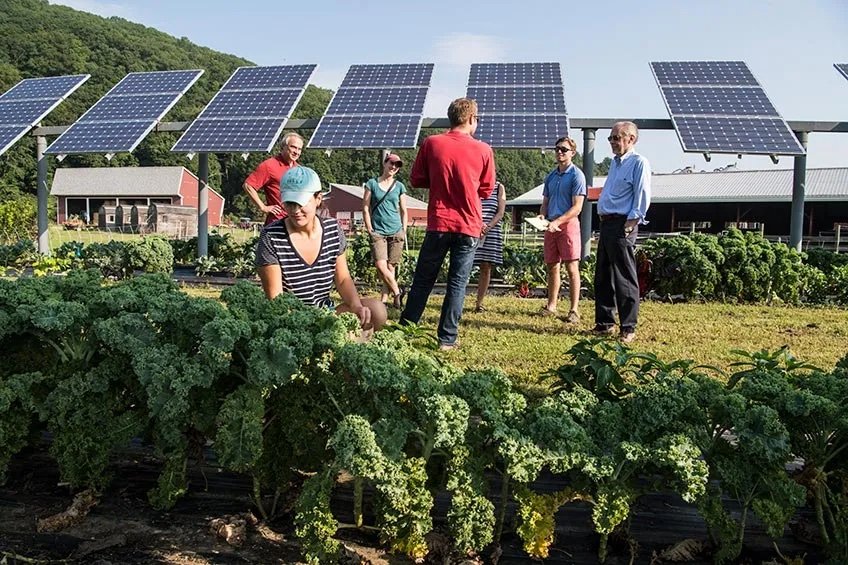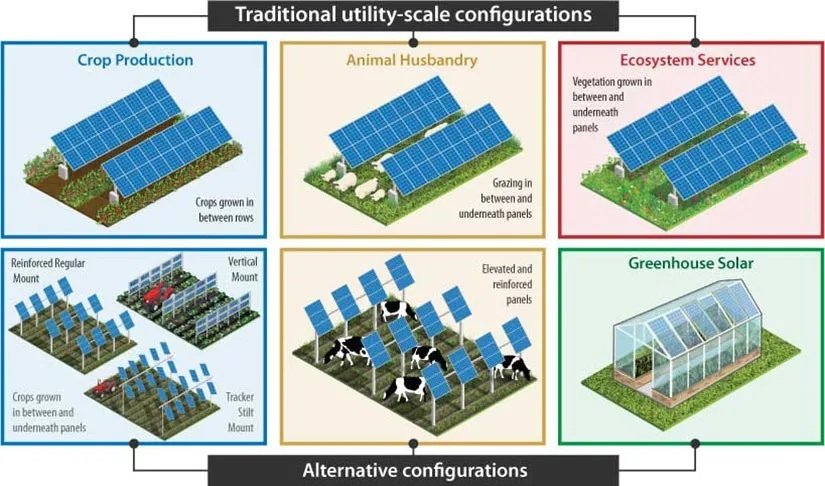Farming + Solar Power: Can Agrivoltaics Cultivate a Brighter Future in Florida?
Florida’s energy problem: overreliance on natural gas
In Florida, about 75% of electricity is generated from natural gas-powered plants. Many Floridians, without even realizing it, experienced the downsides of our lopsided reliance on this one source of fuel. In 2022, the world witnessed a drastic surge in natural gas prices due to the war in Ukraine. This price volatility forced some of Florida’s major investor-owned electric utilities like FP&L and Duke to pass along these increased costs to their customers. This posed an enormous challenge to many Florida consumers who live on a fixed income, when a bump in electricity costs meant they had to go without food or medicine. It also posed a challenge for businesses to plan their budgets effectively.
Many kinds of crops can be grown under solar panels. Some crops benefit from the greater shade and cooler temperatures under panels while reducing water needs. Farm manager Brittany Staie harvests tomatoes at Jack’s Solar Garden in Longmont, Colorado. Photo by Werner Slocum, NREL
Natural gas price volatility and our overreliance on this one fuel as our main source of electricity in Florida underscore the importance of diversifying our energy sources. And while solar energy seems like an obvious energy source to transition to in the Sunshine State, there are some critics who point to the downsides of building the kind of utility-scale solar plants that would be required to generate the amount of electricity needed to replace natural gas. These large-scale solar farms take up lots of land — land that could otherwise be used for farming. This is where a new concept called “agrivoltaics” comes into the equation, which combines two words; “agriculture” with “photovoltaics.” What if there were a way to build large-scale solar systems, and keep the land productive for farming at the same time? This is the puzzle that a group of scientists, engineers, and farmers have been working on: with fascinating results.
What is Agrivoltaics?
Agriculture, from its inception, has been an age-old manifestation of humankind’s ability to harness the power of the sun. Through photosynthesis, we’ve converted sunlight into energy in the form of food – a process that has defined our survival and evolution. Now, in the face of outrageous electricity prices driven by natural gas costs, and a growing demand for renewable energy, a transformative concept called agrivoltaics is reshaping the farming landscape.
The question arises: Can farmers make more money by installing solar panels on their land without giving up the agricultural value of that land? Agrivoltaics, also known as solar sharing or dual-use farming, combines agriculture and photovoltaics to allow farmers to simultaneously grow crops and generate electricity from solar panels on the same land.
The Agrivoltaic Advantage
NREL researcher Jordan Macknick works with teams from University of Massachusetts and Hyperion at the UMass Crop Animal Research and Education Center in Massachusetts. A successful agrivoltaics project must meet the needs of local farmers, solar developers, and the broader community. Because of this, collaboration is essential to ensure all these groups have a voice. Photo by Dennis Schroeder, NREL
The beauty of agrivoltaics lies in its win-win proposition. Farmers aren’t forced to choose between electrons and calories; they can diversify their energy output to produce both.
Solar panels installed in a farm setup capture sunlight and convert it into electricity, contributing to the growing renewable energy grid. Simultaneously, certain crops beneath these panels actually take advantage of the shade and thrive with the moisture retention provided by the structures above.
The agrivoltaic model offers a dual-output system, diversifying farm productivity and making it more resilient to unpredictable market dynamics.
Whether agrivoltaics is the most profitable route depends on several factors, such as the location of the farm, the types of crops grown, the cost of installing and maintaining the solar panels, and the current local market prices for electricity and crops.
Agrivoltaics includes many different uses. Agrivoltaics systems can be installed in the same basic row layout as a traditional large-scale solar plant—or they can be modified to provide extra space for light, animals, or farm equipment to move under and between them. Graphic by Al Hicks, NREL
Generally, areas with abundant sunlight and high electricity prices can significantly benefit from adopting this practice. On the other hand, high-value, shade-tolerant crops such as berries, herbs, and certain vegetables are well-suited for growing under solar panels. Furthermore, farms in water-scarce regions could gain from the lower water requirements due to the cooler, moister microclimate created beneath the solar arrays.
While the upfront cost of installing solar panels might seem steep, government incentives and programs, as well as dropping prices for photovoltaic technology, have made the transition increasingly affordable. Once installed, solar panels can be a reliable source of income for decades, as they typically come with 25-30 year warranties and have life expectancies of 40-50 years.
Agrivoltaics in Florida
Agrivoltaics are already starting on some farms in Florida. In Monticello, Florida, Cetta Barnhart grows citrus trees, greens and other produce that go to a community-supported agriculture project she founded, Seed Time Harvest Farms. And soon, thanks to cooperation from the U.S. Department of Energy National Renewable Energy Laboraty (NREL), there will be a new addition on her property: solar panels.
Cetta Barnhart owns Seed Time Harvest Farms, a community-supported agriculture business in Florida. Photo from Seed Time Harvest Farms
On top of helping Barnhart scope out plans to integrate solar panels on her farmland in a way that benefits her crops and livestock (agrivoltaics), researchers from NREL have also helped the nearby community of Bealsville, Florida lay the foundation for installing solar panels on houses of worship. Bealsville is located around 25 miles east of Tampa.
Bealsville was founded by formerly enslaved people following the Civil War, and it has remained home to Black farmers ever since. It is one among many Black farming communities in Florida facing climate and energy challenges that range from changing weather patterns to high energy costs.
And the big monopoly utilities are starting to catch on to this concept as well. In June, energy giant FP&L opened a new facility near Milton, Florida (in Santa Rosa County), which will include some agrivoltaic concepts. The new Blackwater River Solar Energy Center will generate 74.5 megawatts of clean energy, according to the company’s project website.




